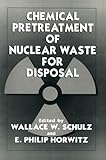Chemical pretreatment of nuclear waste for disposal [Libro electrónico] / edited by Wallace W. Schulz, E. Philip Horwitz
Schulz, Wallace W [editor] | Horwitz, E. Philip [editor/a].
Tipo de material: Libro
en línea Series Editor: New York, New York, United States: Plenum Press, c1994Descripción: viii, 212 páginas : ilustraciones ; 26 centímetros.ISBN: 030644898X; 9781461360766 (Print); 9781461525264 (Online).Tema(s): Radioactive wastes -- PurificationNota de acceso: Disponible para usuarios de ECOSUR con su clave de acceso Nota de bibliografía: Incluye bibliografía e índice: páginas 211-212 Número de sistema: 55316Contenidos:Mostrar
Resumen:
Libro
en línea Series Editor: New York, New York, United States: Plenum Press, c1994Descripción: viii, 212 páginas : ilustraciones ; 26 centímetros.ISBN: 030644898X; 9781461360766 (Print); 9781461525264 (Online).Tema(s): Radioactive wastes -- PurificationNota de acceso: Disponible para usuarios de ECOSUR con su clave de acceso Nota de bibliografía: Incluye bibliografía e índice: páginas 211-212 Número de sistema: 55316Contenidos:Mostrar
Resumen:| Tipo de ítem | Biblioteca actual | Colección | Signatura | Estado | Fecha de vencimiento | Código de barras |
|---|---|---|---|---|---|---|
| Libros | Biblioteca Electrónica Recursos en línea (RE) | Acervo General | Recurso digital | ECO400553164224 |
Incluye bibliografía e índice: páginas 211-212
Separations technology: the key to radioactive waste minimization.. Chemical pretreatment of savannah river site nuclear waste for disposal.. Disposal of Hanford site tank waste.. Process chemistry for the pretreatment of Hanford tank wastes.. Removal of actinides from Hanford site wastes using an extraction chromatographic resin.. Chemical mechanisms for gas generation in tank 241sy101.. Combined TRUEX-SREX extraction/recovery process.. Noble metal fission products as catalysts for hydrogen evolution from formic acid used in nuclear waste treatment.. Microbiological treatment of radioactive wastes.. Treatment of high-level wastes from the IFR fuel cycle.. SOIL*EXSM-an innovative process for treatment of hazardous and radioactive mixed waste.. Clean option: an alternative strategy for Hanford tank waste remediation; detailed description of first example flowsheet.. Index
Disponible para usuarios de ECOSUR con su clave de acceso
Chemical pretreatment of nuclear wastes refers to the sequence of separations processes used to partition such wastes into a small volume of high-level waste for deep geologic disposal and a larger volume of low-level waste for disposal in a near-surface facility. Pretreatment of nuclear wastes now stored at several U. S. Department of Energy sites ranges from simple solid-liquid separations to more complex chemical steps, such as dissolution of sludges and removal of selected radionuclides, e. g. , 90Sr, 99Tc, 137CS, and TRU (transuranium) elements. The driving force for development of chemical pretreatment processes for nuclear wastes is the economic advantage of waste minimization as reflected in lower costs for near-surface disposal compared to the high cost of disposing of wastes in a deep geologic repository. This latter theme is expertly and authoritatively discussed in the introductory paper by J. and L. Bell. Seven papers in this volume describe several separations processes developed or being developed to pretreat the large volume of nuclear wastes stored at the US DOE Hanford and Savannah River sites. These papers include descriptions of the type and amount of important nuclear wastes stored at the Hanford and Savannah River sites as well as presently envisioned strategies for their treatment and final disposal. A paper by Strachan et al. discusses chemical and radiolytic mechanisms for the formation and release of potentially explosive hydrogen gas in Tank 241-SY-101 at the Hanford site. eng
Disponible en línea
Disponible en formato PDF
Subscripción a ELSEVIER 26 de diciembre del 2013
